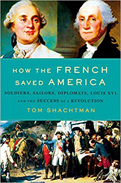
 |
How the French Saved America: Soldiers, Sailors, Diplomats, Louis XVI, and the Success of a Revolution
by Tom Shachtman
St. Martin's Press
Early in the American Revolution, a French emissary for Louis XVI, a king who fancied replacing the British handhold on America with his own, secretly visited the colonies to both measure the resistance and consider future prospects. The emissary was impressed, if not startled, by America’s resolve to achieve independence. France’s expectations needed to be adjusted. Their best hopes were to weaken and humiliate England by assisting the rebels. However, given the tentative truce in Europe, this needed to be launched under cover for as long as possible. Thus begins Tom Shachtman’s unique perspective of how a rebellion succeeded.
For more than two hundred years, the American Revolution has been characterized as a colonial uprising by brave upstarts against an underestimating motherland that eventually found itself worn out and overwhelmed. This legend is typically recited in history classes across the United States, but that’s only part of the story. The first half of the revolution can be classified as a series of blunders, misfortunes, and narrow escapes from utter defeat. If it weren’t for the timely aide in the form of supplies and experience from the French, the foolhardy resilience of the Americans, and the constant political maneuvering on the part of both, the colonial campaign against the British would have collapsed.
George Washington, as documented in his letters and pleas to congress, staff, and just about anyone who would listen, understood the plight and urgency of the revolt as well as anyone. Not only did he overcome his own miscues, he learned to expect nothing to go as planned. His military officers coveted their own agendas, supplies and reinforcements showed up days or weeks late, and his troops were woefully unprepared. Although the troops were never perfect, France may have been the key factor in helping Washington's army to act like one.
Eventually, Europe recognized more opportunity in America than opposition, and the tide of war turned. Together the colonists and France marched to Yorktown where Washington laid siege and finished the war, or at least this phase of America’s birth. The country was still a mostly unknown continent to form over decades with liens against it from various foreign factions that needed to be resolved by guile and force. Here, at the midpoint of Shachtman’s unique and studied contribution to U.S. history, the book pivots to further expand France’s role in securing America’s foothold after victory.
Shachtman is a detailed researcher, who is both a historian’s and biographer’s dream. With books such as Rumspringa, Whoever Fights Monsters, and American Iconoclast, he delves into the parts that others overlook to form a complete picture. He goes for the extra third of information, the deep research that leaves little debate regarding events. One of his greatest strengths is that his opinion rarely bleeds onto the pages, yet he still interjects unique observational skills and the occasional takeaway line. He becomes fascinated with the subject, not arbiter of it as many modern biographers tend to be.
How the French Saved America follows the mode of Dumas Malone’s classic study of Jefferson, where the story is unearthed through the discovery of fact. The book is heavily annotated and indexed, leaning toward scholarly but eminently readable. Since history has reduced much of France’s involvement in the American Revolution to exchanges between Washington and Lafayette, Shachtman’s new accounting reveals the enormous contribution France made in blood, treasure, and political capital to secure America’s independence.
RECOMMENDED by the US Review
Next Focus Review
Previous Focus Review